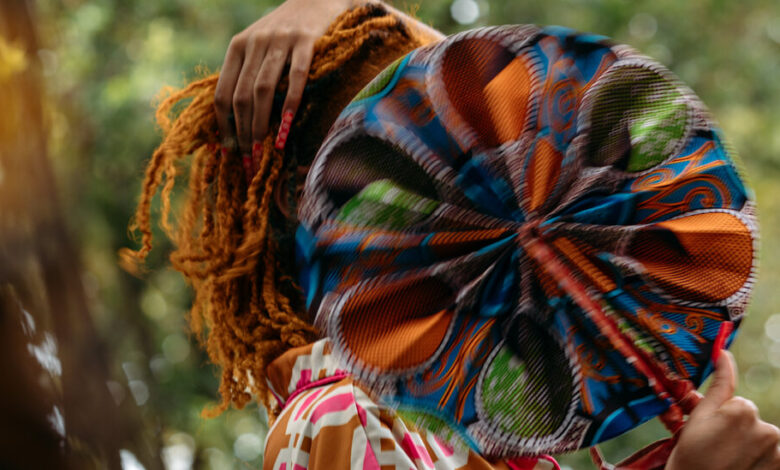Want to Stay Cool? Try Ankara Hand Fans.

The subway wasan oven. Humid air engulfed my mother, sister and me as we stood waiting for the train to take us to Times Square to see “The Lion King” musical. It was the first 90-degree day of the year, and I had forgotten what such heat felt like. Instinctively, my sister and I both reached for our African hand fans and began cooling our mother.
I call them African hand fans, but “folding Ankara hand fans” is more specific. They are ubiquitous in certain corners of Brooklyn. You can buy them for $25 on Tompkins Avenue — a tad pricey, perhaps, but worth every penny. They’re made of Ankara fabric, a bright batik wax material common all over West Africa. They come in a dazzling array of colors: Mine is orange and yellow, my sister’s white and blue. They are an incredibly versatile accessory, offering blissful respite on a crowded dance floor, or a makeshift form of shade at the beach. At a wedding, they are an excellent companion during the reception. Stuck in a broken elevator on a humid day with a pregnant co-worker? Humbly offer her your fan. Children are drawn to them by nature. They are tailor-made for impromptu photo shoots, easy conversation starters when small talk must be had, striking outfit enhancers.
They’re shorthand for something too — representative of the kind of amalgamated pan-Africanism that appeals to some Black people in the diaspora who yearn for connections to a romanticized version of Africa that doesn’t actually exist. An owner of these fans might have a tub of raw shea butter in their bathroom cabinet or an Asante foot stool they bought from a resale shop in Queens. They might say “grand rising” or claim to be “plant-based.” I’m being cheeky here, but as a Nigerian American, I simultaneously relate to that yearning and feel embarrassed by it.
Growing up, I was either trying to connect to my Nigerian-ness or, more often, rejecting it, depending on how insecure I felt at any given moment. I spent my early childhood in Gambia, so my family visited Nigeria often. It was never quite home, though. When we moved to the United States for good, those trips became less frequent, and my relationship to Nigeria became more complicated. I spent years wondering why my parents didn’t give us English names, and I had little desire to learn how to cook Nigerian food, or speak Yoruba or Urhobo, their native tongues. In a tiny, subconscious way, my Ankara hand fan is overcompensation for those years of shame.
Here’s the curious thing, though: I don’t remember seeing these Ankara hand fans when I lived in Gambia, or when we visited Nigeria. They appear to be a somewhat recent innovation. My mother confirmed as much to me when she visited in mid-May. The day before our subway adventure, while browsing at a local store that sells cowrie-shell-shaped gold jewelry and incense, she pointed to the stack of Ankara hand fans charmingly displayed and said that her family never had fans like that growing up in Lagos. “We made our own out of paper,” she said. The Ankara fans, she added, must have become popular more recently.
A Nigerian friend around my own age says that you can buy them at markets back home for 3 to 5,000 naira (about $7 to $12 U.S.). I would like to think that these fans are an ancient rite, steeped in history and tradition, like aso oke, a hand-woven cloth, usually cotton, that Yoruba people have been making for centuries and that involve a beautiful yet time-intensive process. These fans are often made by dedicated West African artisans — but they could also, perhaps, be mass produced in Chinese factories. Regardless, my fretting over the authenticity of these hand fans misses the point. The technique used to make the Ankara fabric is not indigenous to West Africa. Indonesians have been making batik wax fabrics since the sixth century, according to The Jakarta Post. When the Dutch colonized Indonesia during the 19th century, they began shipping batik all over the world, including to West Africa. The colors and patterns, which often had specific names like Kilikili Star, came to be associated with various families and ethnic groups. Today, for most special occasions in Nigeria, and even for more mundane activities — shopping, walking, going to dinner — people might wear Ankara.
So an Indonesian technique that arrived in West Africa via trade with the Dutch becomes virtually synonymous with West Africa. The folding hand fan, meanwhile, believed to have been invented by the Chinese or the Japanese, becomes a ubiquitous accessory in Nigeria as well. There’s something surreal and appealing about those connections, fraught though they are with the specter of colonialism and cheap labor. The murky heterogeneity of the fan’s origin reassures me: It’s comforting that it echoes my own jumbled background. Cultural authenticity is a gnarly concept, hard to prove in so many respects. Ankara hand fans show that it might also be a futile pursuit.
A few months ago, I was in Columbus, Ga., for a wedding. I wore a dark green dress that matched my fan. “Such a smart choice,” an older woman told me on the dance floor. I basked in the glow of her praise, but ultimately I credit all the unknown people whose ingenuity gave us the Ankara folding fan. Anxiety over authenticity be damned! I just want to keep cool.
Tomi Obarois the author of the novel “Dele Weds Destiny” and an editor at BuzzFeed News.